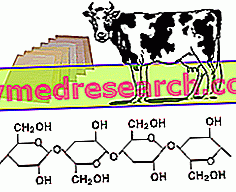CELLULOSE is a homogeneous polysaccharide, which differs from starch in that it is formed by b-glucose, where the single molecules, with a B-1, 4 bond, are rotated with respect to each other by 180 °; the fact that each molecule is rotated 180 ° with respect to the one with which it is bound, causes the cellulose molecule to assume a linear structure; this rotation does not occur in the case of the a-1.4 starch bonds, and this is why amylose, consisting of a-1, 4 a-glucose bonds, has a non-linear but spiral-shaped structure.

Cellulose can also be used in the production of carboxy-methyl-cellulose, a substance of herbal and cosmetic interest; it is considered a mass laxative, of volume, to be taken together with high quantities of water.
Cellulose is also used in the production of explosives and various products of health interest. It is easily obtained from common sources of fiber, from which we also obtain products for textile use, or for medical - surgical aids (gauze, cotton wool). The source, in this case, is cotton, Gossipium irsutum ; the drug is made up of protective hair that envelops the seed; hairs that are collected, processed and spun up to obtain medical - surgical elements, which can also be sold in typical exercises of the sphere of herbal interest.
Microcrystalline cellulose is instead obtained from the waste of timber processing, through a chemical-physical process called "wood explosion"; this process is performed by placing these wastes in an alkaline solution, at temperatures of 200 - 220 ° C and at pressures over 40atm; this favors the solubilization of the lignin, which passes into solution, while the subsequent and sudden passage from the pressure of + 40atm to the atmospheric one favors the disintegration of the cellulose fibers, which thus remain free in solution, to then be extracted with reagents suitable to obtain microcrystalline cellulose, useful as a film-forming substance, for the production of thickeners or excipients.



